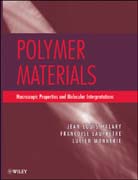
Polymer materials: macroscopic properties and molecular interpretations
Halary, Jean Louis
Laupretre, Francoise
Monnerie, Lucien
INDICE: LIST OF SYMBOLS. PREFACE. INTRODUCTION TO POLYMER MATERIALS. 1. Chronological landmarks for polymers. 2. The polymer chain. 3. The key points of polymer synthesis. 4. Major polymers. 5. The lightness of polymer materials. 6. Main mechanical aspects of polymer materials. 7. Comprehensive survey of thepolymer mechanical behaviors. PART 1. Chapter 1. THE FOUR CLASSES OF POLYMER MATERIALS. 1. The Young modulus. 2. Uncross-linked amorphous polymers. 3. Semi-crystalline thermoplastics. 4. Thermosetting polymers. 5. Cross-linked elastomers. 6. Conclusions. Chapter 2. THE MACROMOLECULAR CHAIN IN THE AMORPHOUS BULK POLYMER: STATIC AND DYNAMIC PROPERTIES. 1. Conformational statistics of isolated polymer chains. 2. Conformational energy calculations. 3. Global properties of an isolated chain. 4. Chain conformations in bulk amorphous polymers. 5.Local dynamics of isolated chains. 6. Local dynamics of a polymer chain in solution. 7. Local dynamics in bulk polymers. 8. Conclusions. Bibliography. Chapter 3. THE GLASS TRANSITION. 1. Experimental studies. 2. Molecular origin of the glass transition temperature. 3. Overview of the glass transition temperature theories. 4. Effect of the polymer architecture on the glass transition temperature. 5. Effect of the polymer chemical structure on the glass transition temperature. 6. Glass transition of random copolymers. 7. Glass transition of polymer/plasticizer blends. 8. Conclusions. Bibliography. Chapter 4. SECONDARYRELAXATIONS IN AMORPHOUS POLYMERS. 1. Experimental evidences of a secondary relaxation. 2. Identification of the motions which are responsible for the secondary relaxations. 3. Motional cooperativity associated with secondary relaxations. 4. Secondary relaxations of poly(methyl methacrylate) and some of its random copolymers. 5. Secondary relaxation of neat and antiplasticized bisphenol-A polycarbonate. 6. Secondary relaxations in neat and antiplasticized aryl-aliphatic epoxy resins. 7. Conclusions. Bibliography. Chapter 5. ENTANGLEMENTS IN BULK UNCROSS-LINKED POLYMERS. 1. Concept of entanglement. 2. Experimental determinations of Me. 3. Theoretical overview of chain dynamics. 4. Relationships between entanglements and polymer chemical structure. 5. Conclusions. Bibliography. Chapter 6. SEMI-CRYSTALLINE POLYMERS. 1. Experimental evidence of semi-crystalline state. 2. Crystalline structure of polymers. 3. Morphology of semi-crystalline polymers. 4. Crystallization kinetics. 5. Melting temperature ofcrystalline domains. 6. Influence of the polymer chemical structure. 7. Glasstransition of semi-crystalline polymers. 8. Conclusions. Bibliography. PART 2. Chapter 7. ELASTIC AND HYPER-ELASTIC BEHAVIORS. 1. Definition and physical origin of an elastic behavior. 2. Enthalpic elasticity (true elasticity). 3. Entropic elasticity (hyper-elasticity or rubber elasticity). 4. Con
- ISBN: 978-0-470-61619-2
- Editorial: John Wiley & Sons
- Encuadernacion: Rústica
- Páginas: 432
- Fecha Publicación: 18/02/2011
- Nº Volúmenes: 1
- Idioma: Inglés
